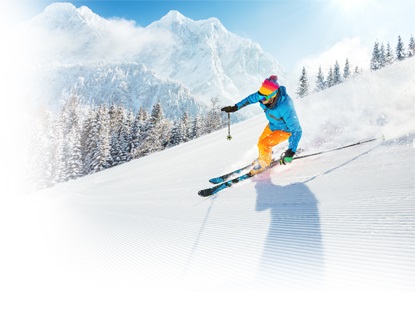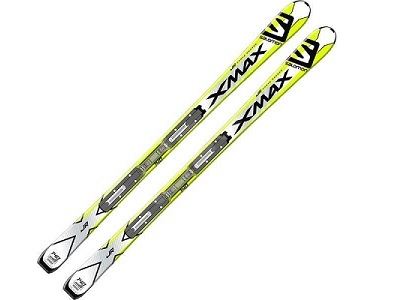

How To Choose a Downhill Skis
Making the right choice of downhill skis is influenced by several factors, particularly the terrain on which they are to be used, the level of skiing ability, and last but not least, the height and weight of the skier.

Frequently asked questions when choosing downhill skis
Is it hard to start skiing? Which skis should I choose?
In terms of technical complexity, you will probably find skiing to be easier than, for example, snowboarding. In the beginning, you are unlikely to be able to avoid a number of unpleasant falls, but the ski binding, unlike the snowboard, will unbuckle in the event of a fall, thus eliminating the risk of an ankle or leg fracture. When starting out, choose shorter skis with a more pronounced curve as this will make learning to ski easier for you.
How to choose skis according to the type of terrain?
When choosin the right skis, you should definitely take ito account what terrain you like to ride or you expect to ride. Each type of terrain (see below) requires a certain type of skis.
- Well-maintained piste - universal skis
- All-day skiing on partially maintaned, but also soft track with the surrounding terrain - it is good to use the "all-mountains" skis
- Slopes and terrain - all-mountain models are a good choice, look for those with a wider waist
- Mostly terrain - look for the "off-piste" or "freeride" skis
- Special use (powder, ski mountaineering, snow park) - special types of skis are used for these purposes
How to prepare skis for the season?
Skis are not very difficult to maintain. Just make sure to check them before the start of the season and, if necessary, set the bindings correctly (the binding settings are adapted to the skier's weight), check and wax the bases and sharpen the edges.
How to take care of skis during the season?
After each day on the slopes remember to:
How to use wax for downhill skis?
Ski waxing is not rocket science. If you are wondering which ski wax will be most suitable for you, think about the ambient temperature. Manufacturers divide the types of waxes according to the temperature for which they are intended. There are also a number of specialized waxes, among the basic types you will find the following five:
How to choose skis for children?
Choosing downhill skis for a child is not complicated, you just need to follow a simple principle: The correct length of skis should be 10 to 20 centimeters shorter than the child' s height. This means that a child with a height of 100 centimeters should not ski on skis longer than 90 cm. You can find the size of the skis in the following table more clearly:
| Child's height | Ski length |
|---|---|
| 80 - 90 cm | 70 cm |
| 100 cm | 80 - 90 cm |
| 105 cm | 90 cm |
| 110 cm | 90 - 100 cm |
| 115 cm | 100 cm |
| 120 cm | 100 - 110 cm |
| 125 cm | 110 cm |
| 130 cm | 110 - 120 cm |
| 135 cm | 120 cm |
| 140 cm | 120 - 130 cm |
| 145 cm | 130 cm |
| 150 cm | 130 - 140 cm |
How to choose the right poles for downhill skis?
As a guide, you can calculate the right length of your ski poles by multiplying your height by 0.7. However, it is best to try out the poles and see if they really are the right length.
If you ski with poles which are too short, you would have to crouch unnaturally low when on the piste. Ski poles that are too long would force you to move your center of gravity too far back and again, you would not have the correct skiing position.
How to choose downhill skis - important parameters


Ski stiffness
The stiffness of the ski is determined by the material used to make their core. Softer cores are made of composite materials, while harder skis tend to have a wooden core reinforced with titanium.

Length of skis
When choosing the length of the skis, apply this rule: the less experienced a skier you are, the shorter the skis you should choose.
How to choose downhill skis – table of recommended ski lengths
| Skier's weight in kg | Skier's height in cm | Ski length in cm – beginner | Ski length in cm – advanced |
|---|---|---|---|
| 18+ | 114+ | 98+ | 108+ |
| 23+ | 122+ | 106+ | 116+ |
| 27+ | 130+ | 114+ | 124+ |
| 32+ | 137+ | 122+ | 132+ |
| 39+ | 145+ | 130+ | 140+ |
| 45+ | 152+ | 138+ | 148+ |
| 52+ | 160+ | 146+ | 156+ |
| 59+ | 168+ | 154+ | 164+ |
| 66+ | 175+ | 162+ | 172+ |
| 73+ | 183+ | 170+ | 180+ |

Ski width
The choice of ski width depends mainly on the terrain in which you will ski. The width of the ski is measured in the binding area, under the boot.
Glossary - downhill skis
Back protector - spine
The back protector is also referred to as the "spine". It serves to protect the back from injury in the event of a fall, and together with the helmet should be part of every skier’s protective equipment.
Base/ skid
The part of the ski that touches the snow.
Radius
The radius of the ski is the geometric value of the side cut of the ski. The smaller the radius of the ski - the more the ski is cut, the better the ski turns, but it is less stable when riding straight. Skis with a larger radius, i.e a smaller cut, are more suitable for direct descent and for experienced riders with good technique.
Binding
The binding is used to attach the ski to the skier's foot. It is designed to unbuckle in the event of a fall, thus eliminating the risk of injury.


Base shape
The base is the part of the ski that touches the snow. There are classic straight cut skis and so-called carving skis. The larger the cut, the easier it will be to turn on skis. However, carving skis with a distinctive cut will reach lower speeds. Therefore, skis with a smaller cut are suitable for a fast ride.